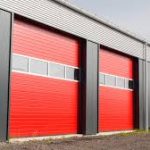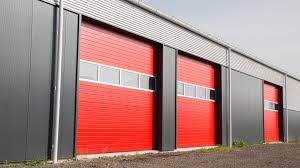Industrial doors, essential components of commercial and industrial buildings, come in various types including roller shutters, sectional doors, high-speed doors, and folding doors, each designed to meet specific operational needs and security requirements.
Fire-Rated Industrial Doors
Fire-rated industrial doors are critical components in commercial and industrial buildings, designed to contain fires and prevent their spread, thereby enhancing overall safety and compliance with building regulations. These specialized doors are engineered to withstand high temperatures for specified periods, typically ranging from 1 to 4 hours.
Key features of fire-rated industrial doors include:
• Fire Resistance: Certified to withstand temperatures up to 1100°C for durations of 30 minutes (FD30), 60 minutes (FD60), 120 minutes (FD120), or even 240 minutes (FD240).
• Smoke Control: Many fire doors are designed to minimize smoke penetration, improving visibility and reducing the risk of smoke inhalation during evacuations.
• Structural Integrity: Built to maintain their form under extreme heat, these doors help preserve the building’s structural integrity during a fire.
• Automatic Closure: Fire-rated doors are often equipped with self-closing mechanisms to ensure they shut automatically when a fire is detected.
Fire-rated industrial doors come in various types to suit different applications:
• Steel Fire Doors: Offer robust protection and are suitable for both internal and external use. They can be customized with different hardware options and locking systems.
• Fire-Rated Roller Shutters: Vertically operating doors ideal for large openings in industrial settings. They can provide fire protection for up to 240 minutes.
• Fire-Rated Sectional Doors: Combine fire resistance with the space-saving benefits of sectional doors, making them suitable for areas with limited headroom.
• Fire-Rated Sliding Doors: Effective for sealing large openings and can be equipped with pedestrian pass doors for everyday use.
• Fire-Rated Hinged Doors: Suitable for pedestrian escape routes and can be installed in fire-resistant walls.
The installation of fire-rated doors offers several benefits:
• Enhanced Safety: Provides crucial time for building occupants to evacuate safely during a fire emergency.
• Regulatory Compliance: Helps businesses meet building codes and fire safety standards, avoiding potential fines or legal issues.
• Insurance Benefits: Many insurance companies offer reduced premiums for buildings with properly installed fire-rated doors.
• Versatility: Available in various materials including steel, wood, and glass, allowing for aesthetic integration with different architectural styles.
When selecting fire-rated industrial doors, it’s essential to consider factors such as the required fire rating, frequency of use, and specific building requirements. Regular maintenance and inspections are crucial to ensure these doors continue to function as intended in the event of a fire.
By incorporating fire-rated industrial doors into building design and safety protocols, organizations can significantly enhance their fire safety measures, protect assets, and most importantly, safeguard human lives.
Sliding Folding Door Applications
Sliding folding doors, also known as bi-fold doors, offer versatile solutions for various industrial and commercial applications. These space-saving door systems provide flexibility and functionality, making them ideal for a wide range of settings.
In industrial environments, sliding folding doors are commonly used in:
• Aircraft hangars: These doors allow for rapid access and clear opening space for large aircraft and equipment. Their design enables efficient use of hangar space while providing security and weather protection.
• Warehouses and loading bays: Sliding folding doors optimize space in high-traffic areas, allowing for smooth operations and easy access for forklifts and other machinery.
• Vehicle workshops and showrooms: The ability to create wide openings makes these doors perfect for displaying vehicles and facilitating their movement in and out of the space.
• Train sheds: Railway maintenance facilities benefit from the large clear openings provided by sliding folding doors, accommodating various train sizes.
Commercial applications of sliding folding doors include:
• Restaurants and retail stores: These doors create flexible spaces, allowing businesses to adapt their layout according to needs, such as opening up to outdoor seating areas.
• Office spaces: Sliding folding doors can divide larger areas into smaller sections, providing versatility in workspace configuration.
• Healthcare facilities: Hospitals and clinics utilize these doors for their space-saving features and easy access, contributing to efficient workflow.
• Educational institutions: Schools and universities use sliding folding doors to optimize classroom spaces and create adaptable learning environments.
Sliding folding doors offer several advantages in these applications:
• Space optimization: They require minimal floor space to operate, making them ideal for areas with limited room.
• Flexibility: These doors can be customized to fit various sizes and architectural designs, offering unparalleled versatility.
• Natural light and views: Large glass panels provide uninterrupted views and allow abundant natural light, enhancing the aesthetic appeal of spaces.
• Energy efficiency: Many sliding folding doors come equipped with energy-efficient glazing, providing excellent insulation and reducing energy consumption.
• Enhanced security: Modern sliding folding doors feature advanced locking systems and robust materials, ensuring maximum security for industrial and commercial premises.
• Rapid access: The folding mechanism allows for quick opening and closing, which is particularly beneficial in high-traffic industrial environments.
When selecting sliding folding doors for specific applications, it’s essential to consider factors such as the required clear opening width, frequency of use, and environmental conditions. Some systems, like the Folding Access™ door, are designed for high-traffic areas and incorporate safety features such as emergency breakout and low closing force.
By incorporating sliding folding doors into industrial and commercial spaces, businesses can optimize their operations, enhance flexibility, and create more inviting and functional environments.
Energy-Efficient Sectional Doors
Energy-efficient sectional doors are a crucial component in modern industrial and commercial buildings, offering significant benefits in terms of thermal insulation, energy savings, and environmental sustainability. These advanced door systems feature high-performance insulation materials and sophisticated sealing mechanisms that work together to minimize heat transfer, reducing energy costs and improving overall building performance.
The core of an energy-efficient sectional door lies in its panel construction. Typically, these doors feature panels with thicknesses ranging from 40mm to 80mm, filled with CFC-free rigid polyurethane foam insulation. This sandwich principle design, with insulation bonded between two galvanized steel sheets, provides exceptional thermal resistance. For instance, Thermo 60mm sectional doors can achieve a U-value as low as 0.77 W/m²K for a 5000 x 5000 mm door, while the more advanced 80mm thick panels can reach an impressive U-value of 0.49 W/m²K.
Key features of energy-efficient sectional doors include:
• Thermal breaks: These prevent heat transfer between the inside and outside surfaces of the door panels.
• Advanced sealing systems: High-quality weather stripping and seals around the door’s perimeter minimize air leakage.
• Insulated vision panels: For doors requiring windows, double or triple-glazed panels with low-emissivity coatings maintain insulation integrity.
• Microprofiled sheet steel: This design enhances both acoustic and thermal insulation properties, making the doors exceptionally weatherproof.
The benefits of installing energy-efficient sectional doors extend beyond mere energy savings:
• Climate control: These doors help maintain consistent indoor temperatures, reducing the workload on HVAC systems and creating more comfortable environments for occupants.
• Cost reduction: By minimizing heat loss in winter and heat gain in summer, these doors can lead to substantial reductions in energy bills.
• Noise reduction: The insulated panels also provide sound attenuation, with some models offering up to 25 dB of soundproofing.
• Condensation prevention: The improved insulation helps prevent condensation formation, protecting goods and equipment from moisture damage.
• Environmental impact: Reduced energy consumption translates to a lower carbon footprint for the building.
When selecting energy-efficient sectional doors, it’s important to consider factors such as the building’s specific insulation requirements, local climate conditions, and frequency of door operation. Some advanced systems incorporate smart controls that use radar technology to optimize door opening times, further enhancing energy efficiency.
While the initial investment in energy-efficient sectional doors may be higher than standard options, the long-term benefits in terms of energy savings, improved comfort, and reduced environmental impact make them a wise choice for forward-thinking businesses. As energy costs continue to rise and environmental regulations become more stringent, these high-performance doors are likely to become an increasingly essential feature in industrial and commercial building design.
Other Industrial Door Types
Industrial doors come in various types to meet specific operational needs across different sectors. Here are some additional industrial door types and their applications:
• High-Speed Doors: Designed for rapid opening and closing, these doors are ideal for high-traffic areas in warehouses, manufacturing plants, and cold storage facilities. They help maintain temperature control, reduce energy costs, and improve workflow efficiency.
• PVC Curtains: Lightweight and cost-effective, PVC curtains are used as flexible barriers in food processing areas, warehouses, and loading docks. They help control temperature, reduce drafts, and prevent dust and contaminants from spreading.
• ATEX Environment Doors: Specially designed for potentially explosive atmospheres, these doors use pneumatic automation systems to ensure safety in chemical plants, refineries, and other hazardous environments.
• Waste Treatment Plant Doors: Large folding doors, capable of spanning widths up to 20 meters and heights of 8 meters, are used in solid urban waste treatment facilities to accommodate vehicle traffic and isolate different processing areas.
• Hospital Sector Doors: Flexible swing doors and rapid roll doors with anti-crash features are used in hospital emergency units to facilitate quick and safe access for ambulances while maintaining environmental control.
• Fire-Resistant Doors: These specialized doors are designed to contain fires and prevent their spread in industrial settings, offering protection for various durations depending on their rating.
• Steel Door Sets: Combining door panels and fixing frames, these robust doors are often used for fire exits and areas requiring high security in industrial facilities.
• Roller Grilles: Similar to roller shutters but with perforated sections, these doors allow for ventilation and visibility while providing security. They are commonly used in retail environments and parking structures.
• Public Transport Doors: Automatic flexible PVC swing doors and high-speed doors are used in bus depots and rail maintenance workshops, accommodating large vehicles and overhead lines.
By selecting the appropriate door type for each application, industrial facilities can optimize operations, enhance safety, and improve energy efficiency across various sectors.
Summary
Industrial doors encompass a wide range of specialized types, each designed for specific applications and environments. From fire-rated doors providing crucial safety features to energy-efficient sectional doors offering superior insulation, and from versatile sliding folding doors to specialized solutions for specific industries, the selection of appropriate door systems is vital for operational efficiency, safety, and energy management in industrial and commercial settings. Understanding the characteristics and applications of different door types helps facilities make informed decisions that optimize their operations while meeting regulatory requirements and sustainability goals.








